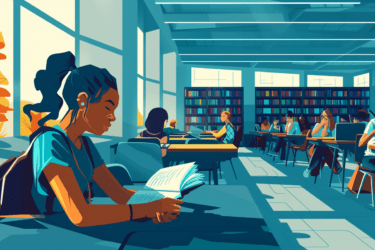While fostering each student’s individuality, any seasoned educator will admit that certain types of personalities are present in any class. Knowing them and finding a unique approach to each of them may be one of the most valuable keys to successful teaching.
Representing AI and plagiarism checker and advocating original writing, we believe that a balance between celebrating each student’s individuality and developing some methods based on the learners’ types is crucial. So, here are some roles students often play in class, and the approach teachers can take to establish healthy group dynamics.
Want-it-all type
They usually engage in all the possible activities, from after-class volleyball to the robotic club. Energetic and eager to take up any challenge, they may face difficulties focusing and prioritizing. That’s where the educator’s role may be vital. A caring teacher may look deeper into the actual students’ talents and aspirations and help them to focus and move towards their real goals instead of constantly attempting to catch up with FOMO.
Star
It doesn’t matter what they do – play sports, dress to kill, or get A’s in every subject without being a nerd. Popular kids get their peers’ admiration and seem to have a perfect school life–at least socially. The blind spot here can be the dependence on someone’s opinions, especially in the vulnerable age of adolescence. So, the teacher may keep an eye on the “celebrity” students to ensure they pursue their goals instead of striving for social appreciation and focus on building genuine connections with people instead of playing a social butterfly role.
Striving one
For some students, things may be harder than for others, but it doesn’t mean it’s not worth the effort. Hard work, focus on their goals, and persistence often make diligent students more successful than their maybe more talented but less committed classmates. These learners also often tend to be attentive to the teachers, asking additional questions and looking for their approval. Giving kudos to their achievements without favoritism is the main challenge in building relationships with the Striving students.
Artist
They may be easily distinguishable by a crazy outfit in school corridors or invisible until you open their project and stare in awe. Creative students invent their unique ways of approaching everything, from mundane school tasks to life choices. Some of their decisions may seem questionable, and their energy can be easily wasted on minor issues. So, the main approach to dealing with artistically gifted students is to respect their individuality and gently direct their creative force to the constructive path.
Good kid
Diligent and respectful, a model student may be shy or self-confident, get the best grades, or struggle with certain subjects—the central point for a Good Kid is to stay convenient and problem-free. Teachers love these students as they never cause trouble. However, it may be helpful to encourage them to speak up and defend their opinions instead of avoiding conflicts and trying to be good to everyone.
Nerd
They seem to live in some parallel universe, unavailable for the others. Despite having difficulties connecting to peers and sometimes being considered odd and reserved, these students are often intelligent, creative, and motivated–so they could use some encouragement.
Leader
They dream of becoming political leaders (or, at least, TikTok influencers.) Motivated and energizing, with a shaped position, they can convince people and inspire them to follow whatever ideas they pursue. Showing respect and fostering leadership qualities are essential for such students. Just ensure they don’t cross the line and their classmates feel comfortable in their self-expressions–leadership is great when it is not authoritarianism!
Lost one
They seem to have no idea what they are doing at school and no intention of finding out. Nevertheless, the teacher may try to spark interest and motivation in such students–at least when you see them in classes, as they tend to skip lessons a lot. Pressure and punishment hardly work on them, but making them inspired or curious may do the trick.
Comic
They make jokes, often inappropriate, and seem to never take anything seriously, including school and the teachers. Sometimes, they are really funny and sometimes annoying, but their role as entertainers and clowns often covers their need to be noticed and appreciated. So, a wise educator may remember to look behind the mask to uncover the true personality behind the stand-up comic role.
Bully
The most challenging category to deal with, as, unlike other types of students who may be annoying but harmless, bullies’ actions often hurt other people. Psychologists say that bullies come from the people who have been hurt themselves, and hurting others is their way to cope with the experience. That being said, the teacher’s primary task is to create a safe and comfortable environment for everyone in the classroom, taking the necessary precautions against those who may pose a danger to others. In the case of bullying, complex actions are required, including counselor help and parental involvement.
Challenger
They consider themselves smarter than any teacher (and sometimes they really are). They are not afraid to ask questions, even tricky and awkward ones (especially tricky and awkward!) They doubt or criticize everything the school authorities say and are not afraid to show it (in fact, they demonstrate it with pleasure!) All in all, they may be pretty annoying but smart and daring. The main challenge in dealing with them is to support their lively mind, critical thinking, and bravery, staying within the teacher-student boundaries. After all, learning to respect others is part of the educational process!

Regardless of the character, type, and role, academic honesty is essential for everyone. PlagiarismCheck.org is here to help teachers accelerate their working routines and assist students in improving their writing. Check out our accurate plagiarism detector, AI checker GPT, and handy LMS integrations now!






